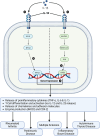Sulphonylureas as Adjunct Therapeutic Agents in the Treatment of Autoimmune Conditions: A Narrative Review
- PMID: 40686254
- PMCID: PMC12277933
- DOI: 10.1002/prp2.70155
Sulphonylureas as Adjunct Therapeutic Agents in the Treatment of Autoimmune Conditions: A Narrative Review
Abstract
A rapid and cost-effective arm of the drug discovery and development process is finding new uses for existing drugs. Initially used as antibacterial agents, sulphonylureas were repurposed for the treatment of type 2 diabetes due to their hypoglycemic side effects. Their primary mechanism of action is mediated by binding to sulphonylurea receptors (SUR), which are atypical adenosine triphosphate binding cassette transporters in pancreatic beta cells. This interaction inhibits ATP-sensitive potassium channels to promote insulin release. Off-target actions of sulphonylureas identified in recent studies have demonstrated a range of anti-inflammatory properties mediated by modulation of the nucleotide-binding oligomerization domain-like receptor pyrin domain-containing protein 3 inflammasomes. Inflammasomes are cytosolic protein complexes that assemble in response to infection or stress-associated stimuli, activating inflammatory responses, and are the primary source of pro-inflammatory cytokines. Sulphonylureas and their derivatives have been shown to inhibit various stages of inflammasome activation, leading to the reduction of pro-inflammatory mediators, including IL-1β and IL-18. Recent evidence demonstrates that these agents reduced inflammatory responses, disease severity, and progression in various preclinical autoimmune and inflammatory models. In this narrative review, we consider the complexity of autoimmune conditions and the limited treatment options, and highlight the potential value of repurposing sulphonylureas and their derivatives as adjunct therapeutics for autoimmune conditions.
© 2025 The Author(s). Pharmacology Research & Perspectives published by British Pharmacological Society and American Society for Pharmacology and Experimental Therapeutics and John Wiley & Sons Ltd.
Conflict of interest statement
The authors declare no conflicts of interest.
Figures


Similar articles
-
Systemic pharmacological treatments for chronic plaque psoriasis: a network meta-analysis.Cochrane Database Syst Rev. 2021 Apr 19;4(4):CD011535. doi: 10.1002/14651858.CD011535.pub4. Cochrane Database Syst Rev. 2021. Update in: Cochrane Database Syst Rev. 2022 May 23;5:CD011535. doi: 10.1002/14651858.CD011535.pub5. PMID: 33871055 Free PMC article. Updated.
-
Flavonoids regulating NLRP3 inflammasome: a promising approach in alleviating diabetic peripheral neuropathy.Inflammopharmacology. 2025 May;33(5):2231-2262. doi: 10.1007/s10787-025-01729-7. Epub 2025 Apr 9. Inflammopharmacology. 2025. PMID: 40205269 Free PMC article. Review.
-
Management of urinary stones by experts in stone disease (ESD 2025).Arch Ital Urol Androl. 2025 Jun 30;97(2):14085. doi: 10.4081/aiua.2025.14085. Epub 2025 Jun 30. Arch Ital Urol Androl. 2025. PMID: 40583613 Review.
-
Sulphonylurea monotherapy for patients with type 2 diabetes mellitus.Cochrane Database Syst Rev. 2013 Apr 30;(4):CD009008. doi: 10.1002/14651858.CD009008.pub2. Cochrane Database Syst Rev. 2013. Update in: Cochrane Database Syst Rev. 2015 Jul 29;(7):CD009008. doi: 10.1002/14651858.CD009008.pub3. PMID: 23633364 Updated.
-
The Black Book of Psychotropic Dosing and Monitoring.Psychopharmacol Bull. 2024 Jul 8;54(3):8-59. Psychopharmacol Bull. 2024. PMID: 38993656 Free PMC article. Review.
References
-
- Rendell M., “The Role of Sulphonylureas in the Management of Type 2 Diabetes Mellitus,” Drugs 64 (2004): 1339–1358. - PubMed
Publication types
MeSH terms
Substances
LinkOut - more resources
Full Text Sources
Medical
Miscellaneous

